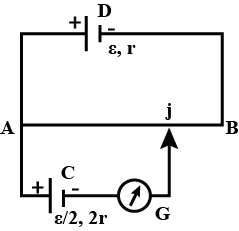
In the figure, the potentiometer wire AB of length L and resistance 9r is joined to the cell D of e.m.f and internal resistance r. The cell C's e.m.f is

A)
B)
C)
D)

Answer
494.7k+ views
Hint: In the figure the potentiometer has no current flowing in between C and galvanometer then only there is no deflection. We have to calculate the length of AJ which is the difference of potential across A and J and then equating them with the potential gradient K by supposing the length of AJ be p. Then we will get our length of no deflection (p) cm or m.
Step by step solution:
Step 1:
A galvanometer works as an actuator, by producing a rotary deflection (of a "pointer"), in response to electric current flowing through a coil in a constant magnetic field. They were the first instruments used to detect and measure small amounts of electric currents.
Potential Gradient is the decrease in potential length per unit length. It is calculated as
Step 2:
Now coming to the question:
The galvanometer is showing no deflection. Let consider a point D between the galvanometer and C. Let the distance of A and J be p.
This implies the potential difference across D and J will be zero=
We are given in question: The cell C's e.m.f is
And also the potentiometer wire AB of length L and resistance
Then total resistance will be
Calculating the I(current) is
Potential across AJ will be the sum of difference of potential difference between A and D, and D and J
This implies
So,
Now, potential gradient (K) is equal to
Putting the value of I we will get K=
We have assumed the distance of A and J is p then K multiplied by p equals to
Then p(length)=
Hence option B is correct.
Note:These are formula based questions. One needs to have a knowledge of potentiometer, galvanometer, the flowing of a current, and most important the potential gradient. The characteristics of a potentiometer are important and without that it is hard to solve such a question. Therefore it is advised to learn the definition and working then only the diagram will reveal the solution automatically.
Step by step solution:
Step 1:
A galvanometer works as an actuator, by producing a rotary deflection (of a "pointer"), in response to electric current flowing through a coil in a constant magnetic field. They were the first instruments used to detect and measure small amounts of electric currents.
Potential Gradient is the decrease in potential length per unit length. It is calculated as
Step 2:
Now coming to the question:
The galvanometer is showing no deflection. Let consider a point D between the galvanometer and C. Let the distance of A and J be p.
This implies the potential difference across D and J will be zero=
We are given in question: The cell C's e.m.f is
And also the potentiometer wire AB of length L and resistance
Then total resistance will be
Calculating the I(current) is
Potential across AJ will be the sum of difference of potential difference between A and D, and D and J
This implies
So,
Now, potential gradient (K) is equal to
Putting the value of I we will get K=
We have assumed the distance of A and J is p then K multiplied by p equals to
Then p(length)=
Hence option B is correct.
Note:These are formula based questions. One needs to have a knowledge of potentiometer, galvanometer, the flowing of a current, and most important the potential gradient. The characteristics of a potentiometer are important and without that it is hard to solve such a question. Therefore it is advised to learn the definition and working then only the diagram will reveal the solution automatically.
Recently Updated Pages
Master Class 9 General Knowledge: Engaging Questions & Answers for Success

Master Class 9 English: Engaging Questions & Answers for Success

Master Class 9 Science: Engaging Questions & Answers for Success

Master Class 9 Social Science: Engaging Questions & Answers for Success

Master Class 9 Maths: Engaging Questions & Answers for Success

Class 9 Question and Answer - Your Ultimate Solutions Guide

Trending doubts
Give 10 examples of unisexual and bisexual flowers

Draw a labelled sketch of the human eye class 12 physics CBSE

Differentiate between homogeneous and heterogeneous class 12 chemistry CBSE

Differentiate between insitu conservation and exsitu class 12 biology CBSE

What are the major means of transport Explain each class 12 social science CBSE

What is the difference between resemblance and sem class 12 social science CBSE




